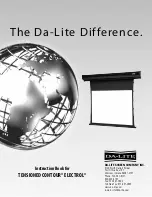
User's Guide ADI-192 DD © RME
37
In QS operation, the ADI-192 DD spreads two channel's data on all 8 channels of an ADAT and
TDIF port according to the following table:
Original 1 2 3 4
DS Signal
Port
1/2
MAIN
3/4
MAIN
5/6
MAIN
7/8
MAIN
1/2
AUX
3/4
AUX
5/6
AUX
7/8
AUX
As the transmission of quad rate signals is done at standard sample rate (Single Speed), the
ADAT and TDIF ports still operate at 44.1 kHz or 48 kHz.
The 'Quad Wire' or 'S/MUX4' technology of the ADI-192 DD's TDIF interface allows to transmit
two channels at up to 192 kHz with every (!) DTRS device.
Unfortunately Tascam's TDIF implementation is incompatible to Quad Wire, as the samples are
not transmitted in the order of 1-2-3-4, but 1-3-2-4. In case the special 192 kHz mode of the
DTRS machine DA-98HR shall be used, the machine should be connected and used with the
ADI-192 DD via AES.
11.5 AES/EBU - SPDIF
The most important electrical properties of 'AES' and 'SPDIF' can be seen in the table below.
AES/EBU is the professional balanced connection using XLR plugs. The standard is being set
by the
Audio Engineering Society
based on the AES3-1992. For the 'home user', SONY and
Philips have omitted the balanced connection and use either Phono plugs or optical cables
(TOSLINK). The format called S/P-DIF (SONY/Philips Digital Interface) is described by IEC
60958.
Type AES3-1992
IEC
60958
Connection
XLR
RCA / Optical
Mode Balanced
Un-balanced
Impedance
110 Ohm
75 Ohm
Level
0.2 V up to 5 Vss
0.2 V up to 0.5 Vss
Clock accuracy
not specified
I:
±
50ppm
II: 0,1%
III: Variable Pitch
Jitter
< 0.025 UI (4.4 ns @ 44.1 kHz)
not specified
Besides the electrical differences, both formats also have a slightly different setup. The two
formats are compatible in principle, because the audio information is stored in the same place in
the data stream. However, there are blocks of additional information, which are different for both
standards. In the table, the meaning of the first byte (#0) is shown for both formats. The first bit
already determines whether the following bits should be read as Professional or Consumer
information.
Byte Mode Bit
0
1
2
3
4
5
6
7
0 Pro P/C
Audio?
Emphasis
Locked
Sample
Freq.
0 Con P/C
Audio?
Copy
Emphasis
Mode
It becomes obvious that the meaning of the following bits differs quite substantially between the
two formats. If a device like a common DAT recorder only has an SPDIF input, it usually under-
stands only this format. In most cases, it will switch off when being fed Professional-coded data.
The table shows that a Professional-coded signal would lead to malfunctions for copy prohibi-
tion and emphasis, if being read as Consumer-coded data.
Nowadays many devices with SPDIF input can handle Professional subcode. Devices with
AES3 input almost always accept Consumer SPDIF (passive cable adapter necessary).
Содержание ADI-192 DD
Страница 4: ...4 User s Guide ADI 192 DD RME...
Страница 5: ...User s Guide ADI 192 DD RME 5 User s Guide ADI 192 DD General...
Страница 12: ...12 User s Guide ADI 192 DD RME...
Страница 13: ...User s Guide ADI 192 DD RME 13 User s Guide ADI 192 DD Usage and Operation...
Страница 29: ...User s Guide ADI 192 DD RME 29 User s Guide ADI 192 DD Technical Reference...
Страница 40: ...40 User s Guide ADI 192 DD RME 12 Block Diagram...




































